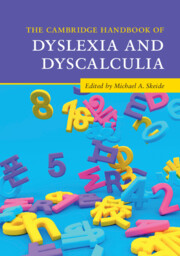Book contents
- The Cambridge Handbook of Dyslexia and Dyscalculia
- The Cambridge Handbook of Dyslexia and Dyscalculia
- Copyright page
- Contents
- Figures and Tables
- Contributors
- Acknowledgements
- General Introduction
- Part I Theoretical Frameworks and Computational Models
- Part II Cognitive Profiles and Behavioural Manifestations
- Part III Genetic and Environmental Influences
- Part IV Neurodevelopmental Foundations
- Part V Gender, Ethnicity, and Socioeconomic Background
- 13 Gender and Sex Differences in Dyslexia and Dyscalculia
- 14 The Role of Socioeconomic and Ethnic Disparities for Dyslexia and Dyscalculia
- Summary: Gender, Ethnicity, and Socioeconomic Background
- Part VI Cultural Unity and Diversity
- Part VII Early Prediction
- Part VIII Intervention and Compensation
- Part IX Best Practice – Diagnostics and Prevention
- Part X Best Practice – Schooling and Educational Policy
- General Summary
- References
- Index
- References
14 - The Role of Socioeconomic and Ethnic Disparities for Dyslexia and Dyscalculia
from Part V - Gender, Ethnicity, and Socioeconomic Background
Published online by Cambridge University Press: 28 July 2022
- The Cambridge Handbook of Dyslexia and Dyscalculia
- The Cambridge Handbook of Dyslexia and Dyscalculia
- Copyright page
- Contents
- Figures and Tables
- Contributors
- Acknowledgements
- General Introduction
- Part I Theoretical Frameworks and Computational Models
- Part II Cognitive Profiles and Behavioural Manifestations
- Part III Genetic and Environmental Influences
- Part IV Neurodevelopmental Foundations
- Part V Gender, Ethnicity, and Socioeconomic Background
- 13 Gender and Sex Differences in Dyslexia and Dyscalculia
- 14 The Role of Socioeconomic and Ethnic Disparities for Dyslexia and Dyscalculia
- Summary: Gender, Ethnicity, and Socioeconomic Background
- Part VI Cultural Unity and Diversity
- Part VII Early Prediction
- Part VIII Intervention and Compensation
- Part IX Best Practice – Diagnostics and Prevention
- Part X Best Practice – Schooling and Educational Policy
- General Summary
- References
- Index
- References
Summary
The ‘overrepresentation’ of racially/ethnically marginalized and socioeconomically disadvantaged children in special education has been of concern to researchers, policymakers, and practitioners since at least the late 1960s (Dunn 1968; Mercer 1973; Coard 1971). The prevailing wisdom has long been that racially/ethnically and socioeconomically marginalized children are both at higher risk of disability due to cognitive and social–emotional–behavioural effects of structural inequalities, and that schools make racially/ethnically and socioeconomically biased decisions to qualify students for special education services (e.g., National Research Council 2002). Newer research has identified more nuanced and complex mechanisms in racial/ethnic inequalities in particular, in which racially/ethnically marginalized students are more likely to need services due to structural inequality, but are largely less likely to gain access to those services when they need them than their White peers (Shifrer and Fish 2020).
- Type
- Chapter
- Information
- The Cambridge Handbook of Dyslexia and Dyscalculia , pp. 251 - 262Publisher: Cambridge University PressPrint publication year: 2022

